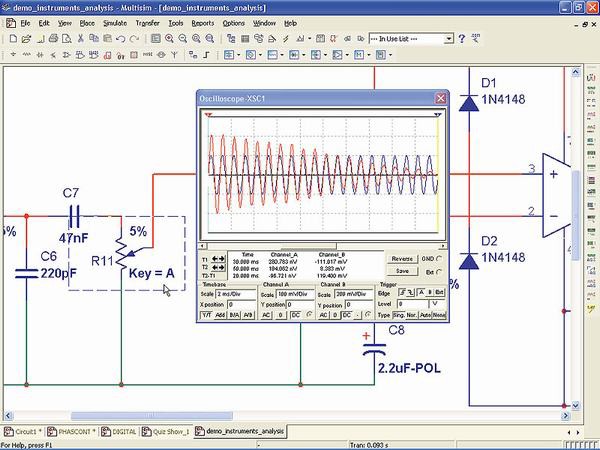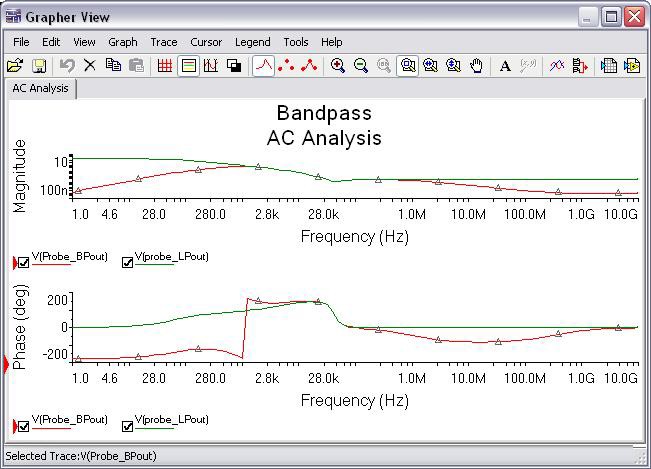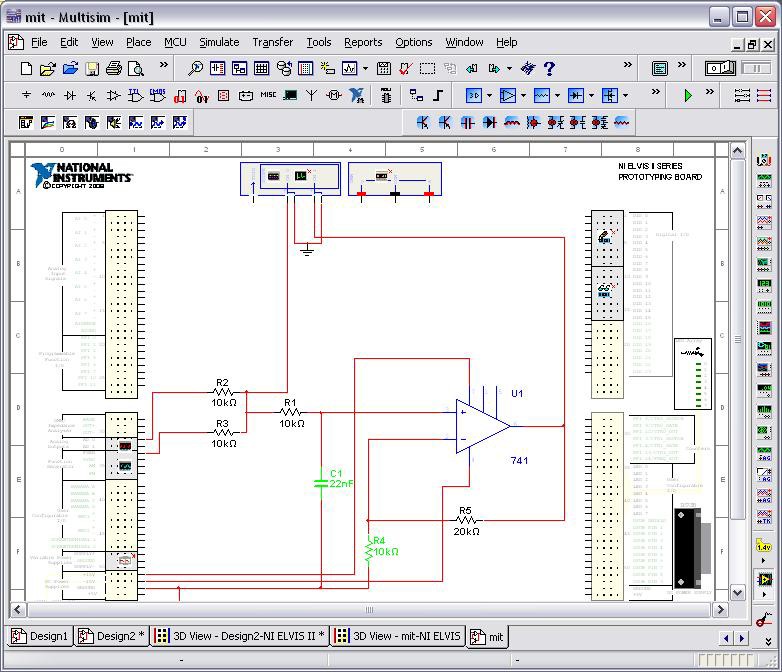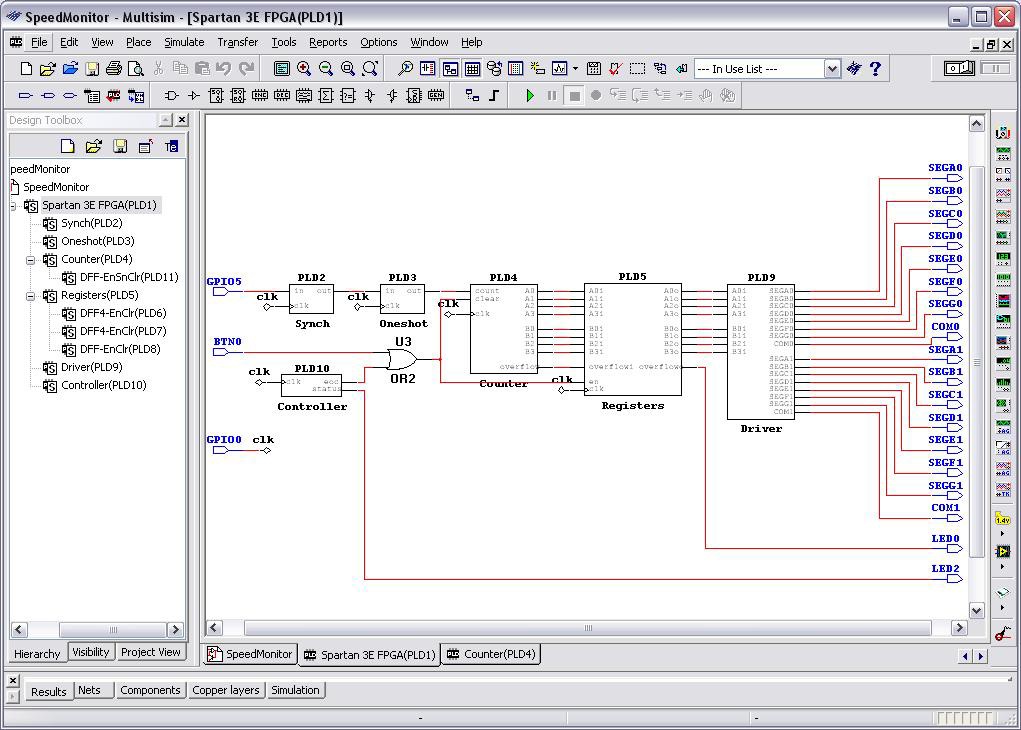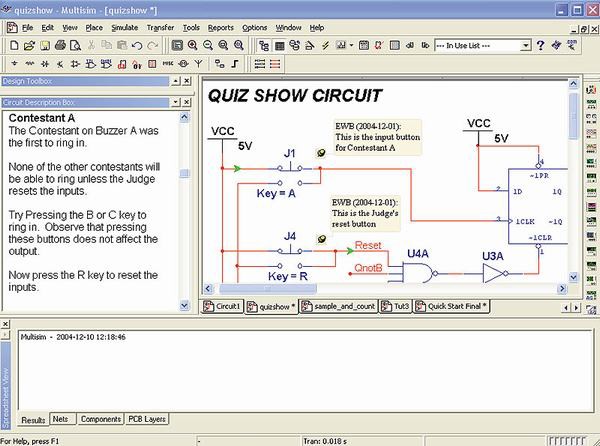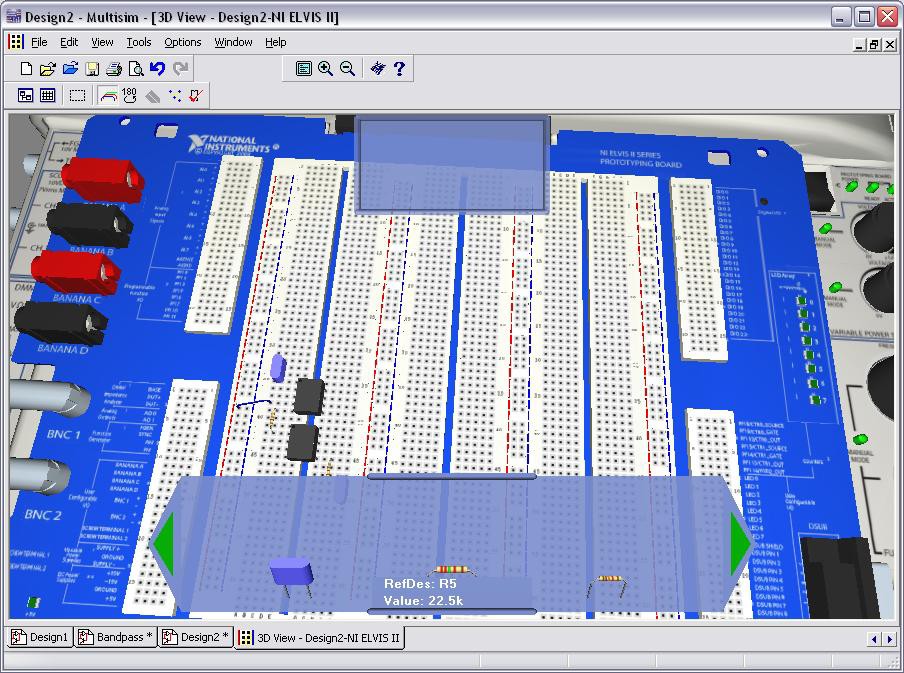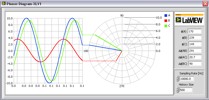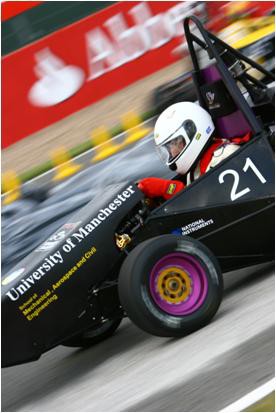Top 10 NI Multisim Educational Features
Overview
Engage students and reinforce theory with a hands-on approach using NI Multisim, an easy-to-use interactive circuit teaching and student learning environment. Developed for academia, Multisim contains specific features that assist educators with delivering course content and provides students an interactive learning environment to visualize and investigate circuit behavior.
Contents
- Ability to Reinforce Theory with Interactive Circuit Simulation
- Exploration with Simulation-Driven Instruments
- Data Visualization Data with 20 Powerful Analyses
- Ability to Compare Simulated Data and Real Measurements from NI ELVIS inside Multisim
- Simplification of the Teaching of Digital Circuits with the PLD Schematic
- Ability to Easily Find the Components You Need
- Powerful Teaching Options for Educators
- Risk-Free Prototype in 3D Breadboarding Environment
- Customization with NI LabVIEW
- Professional Functionality for Advanced Designs
- Related Resources
Ability to Reinforce Theory with Interactive Circuit Simulation
Multisim is an easy-to-use circuit teaching environment that simplifies circuit design by abstracting the complexity of SPICE simulation with a fully interactive simulator. You can bring circuit concepts to life through simulation without worrying about SPICE syntax. With Multisim, students can focus on understanding the circuit concepts instead of getting frustrated with learning the environment. They can modify circuit values on the fly and see the simulation results change in real time. Having students explore “what if” scenarios using simulation reinforces the concepts taught in the classroom or lab.
Figure 1: Simulation driven instrumentation used to visualize simulated data
Exploration with Simulation-Driven Instruments
With Multisim, students can drop simulation-driven instruments onto a circuit schematic and interact with a circuit just like in the hardware lab. They can make measurements, probe, and troubleshoot a circuit with 22 common instruments that look and function like their real-world counterparts. In addition to the Multisim suite of instruments, you can use a simulated Agilent or Tektronix instrument to teach your students how to use real instrumentation from these vendors.
Figure 2: Simulation-Driven Instruments within Multisim
Data Visualization Data with 20 Powerful Analyses
Help students gain intuition for circuit behavior through the in-depth analysis of circuits using 20 powerful Multisim analyses, including transient analysis, noise, Monte Carlo, worst case, and I-V analyzer. Your students can explore how different configurations, component selections, noise, and signal sources affect circuit designs. Visualize this data in the NI Grapher, which displays data, annotates with labels, exports to various file formats, and more.
Figure 3: NI Grapher showing the results of an AC Analysis
Ability to Compare Simulated Data and Real Measurements from NI ELVIS inside Multisim
You can now make the jump from circuit simulation in Multisim to real-world circuits with one click of the mouse. With the launch of Multisim 10.1 and the NI Educational Laboratory Virtual Instrumentation Suite II (NI ELVIS II), National Instruments offers a new approach to hands-on learning by helping students bridge the gap between theory and the real world. They can simulate the theoretical concepts in Multisim, prototype the actual circuit with NI ELVIS, and compare the simulation with real-world measurements inside the Multisim environment using the NI ELVIS schematic and NI ELVIS virtual instruments.
Take a guided tour of the NI electronics education platform»
Figure 4: NI ELVIS II Series schematic view
Simplification of the Teaching of Digital Circuits with the PLD Schematic
Engage students and reinforce theory with a hands-on approach to digital electronics by making hardware implementation easier through the abstraction of complex VHDL. Students can generate raw VHDL from a digital circuit captured and simulated in the programmable logic device (PLD) schematic in Multisim. Using this VHDL file to target field-programmable gate array (FPGA) hardware, such as the NI Digital Electronics FPGA Board, eases the transition from theory explored through simulation to real-world implementation.
Figure 5: Create programmable logic designs in the PLD Schematic
Ability to Easily Find the Components You Need
Find the component you need to teach the concepts you want with more than 14,000 components in the Component Library. These components and unique parts are clearly organized and searchable. Multisim also has commonly used components, including symbols, models, and IPC-standard land patterns, from leading manufacturers such as Analog Devices, Linear Technology, Maxim Microchip, National Semiconductor, and Texas Instruments to introduce students to components used in industry.
The unique types of components in Multisim are listed below:
- Interactive components such as switches and potentiometers can be manipulated while the simulation is running.
- Animated components such as LEDs and seven-segment displays change their appearance in response to simulation results.
- Virtual components allow you to set their parameters to any value you like — even if you cannot actually find a part with those values in real life. This is great for illustrating theoretical concepts.
- Rated components enhance student learning by “blowing up” if certain parameters (for example, power or current) are exceeded.
- 3D components use photographs that look just like the real thing to replace traditional schematic symbols. This helps students in introductory courses make the leap in understanding the difference between schematics and real circuit designs.
Figure 6: Examples of various types of components in Multisim
Powerful Teaching Options for Educators
Designed with the educator in mind, Multisim incorporates academic features that simplify the teaching of circuit concepts and electronics. You can customize the Multisim user interface as well as the instruments and analyses that are available to control what a student can see and access within a circuit. This provides a range of powerful teaching options and the flexibility to introduce concepts in a controlled fashion so you can match the software's complexity to the student's level or course content. You also can easily add narrative and graphics to circuit files to further explain concepts in a lab or self-study environment. In addition, you can create and distribute reusable simulation profiles, each of which contains a complete SPICE parameter setup to ensure your students complete their assignments successfully as they become familiar with simulation. Circuit restrictions provide instructors the ability to set up hidden faults to teach troubleshooting skills. Or lock and hide subcircuits to create "solve the black box" problems. The easy-to-use Electrical Rules Check, which features visual error markers and "zoom to error" functionality, helps students quickly locate and correct their own wiring errors to avoid frustration and save valuable lab time. In addition, you can place measurement probes anywhere on a circuit to annotate a schematic with dynamic voltage and current values.
Compare the differences between the Multisim Education Edition and the Multisim Student Edition»
Figure 7: Create interactive designs to allow exploration
Risk-Free Prototype in 3D Breadboarding Environment
:You can help students ease into hardware prototyping with the Multisim 3D breadboarding environment and choose from common breadboard, NI ELVIS I, and NI ELVIS II series breadboarding environments. Students can build their circuits and perform experiments in a 3D breadboarding environment as a prelab before walking into the lab.
Figure 8: NI ELVIS II Series Multisim 3D Environment
Customization with NI LabVIEW
Using the power of LabVIEW graphical programming, Multisim offers the unique ability to incorporate custom VIs that extend your simulation and analysis capabilities beyond anything currently available. You can use the LabVIEW VI inside Multisim to teach difficult-to-understand or complex topics such as phasors or the control of an elevator. With LabVIEW, you can create or edit these LabVIEW VIs to meet your needs.
Additionally, Multisim and LabVIEW are unique in their ability to compare simulated and real measurement data as a part of an integrated platform. Through this integration, LabVIEW is able to acquire not only measurement data from hardware but also simulation output from Multisim. With both sets of data in a single interface, you can easily compare and correlate the data. You can use LabVIEW to analyze how the hardware prototype deviates from the expected results found in simulation.
Figure 9: Phasor Diagram LabVIEW Instrument
Professional Functionality for Advanced Designs
Multisim is not only one of the world's most widely used software packages in electronics education but also a popular tool in the professional electronic design automation (EDA) market. As such, it includes functionality that is beyond the needs of many students; however, it is available for senior design courses, post-graduate work, or research projects.
Take advantage of functionality such as project management, powerful bus support, hierarchical and multisheet designs, design constraints that pass to printed circuit board (PCB) layout, a powerful spreadsheet view, circuit wizards that autogenerate circuitry to match your designated parameters, variant support, and more. The professional functionality of Multisim easily handles more complex designs as you prepare students to tackle the complex engineering challenges of tomorrow.
Figure 10: University of Manchester designs high-performance electronics for Formula One race car
